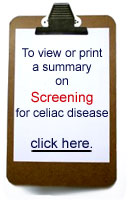 The symptoms of celiac disease are non-specific and vary greatly from one person to another. More than half of the common symptoms in adults are often not recognized as gut related. The similarity of celiac disease with those of other diseases often results in a misdiagnosis of irritable bowel syndrome, primary lactose intolerance, chronic fatigue syndrome or diverticulosis.
The symptoms of celiac disease are non-specific and vary greatly from one person to another. More than half of the common symptoms in adults are often not recognized as gut related. The similarity of celiac disease with those of other diseases often results in a misdiagnosis of irritable bowel syndrome, primary lactose intolerance, chronic fatigue syndrome or diverticulosis.
For the purposes of screening for celiac disease, there are numerous symptoms that should be viewed as a sign to consider celiac disease.
Below are descriptions of various presentations of celiac disease:
Symptomatic
Intestinal related classical symptoms of celiac disease:
- abdominal pain (bloating, cramping or gas)
- weight loss (presence of obesity does not exclude the diagnosis)
- constipation
Extra-Intestinal
Extra-intestinal symptoms secondary or independent of malabsorption:
- anemia (deficiency of iron or folic acid (often both) or vitamin B12)
- deficiency of vitamins A, D, E, K
- bone pain or bone loss
- (related to bones – osteoporosis, arthritis and joint pain)
- chronic fatigue (weakness, extreme lethargy, and depression)
- skin problems (intense burning and itching rash – Dermatitis Herpetiformis)
- dental enamel defects
- neurological symptoms such as paresthesias, ataxia, seizures and migraines
- related to reproductive system(infertility, miscarriages, menstrual irregularities)
- mouth ulcers
- lactose intolerance
- abnormal liver enzymes
- swelling of ankles and hands
Children Specific Symptoms
Classic considerations
- abdominal distension
- anorexia
- diarrhea (chronic)
- failure to thrive
- irritability
- wasting of fat and muscle
Non-classic considerations
- anemia (usually persistent or recurrent iron deficiency)
- arthritis and chronic abdominal pain
- constipation
- delayed puberty
- dental enamel defects
- Dermatitis Herpetiformis
- abnormal liver enzymes
- short stature
- vomiting
Silent Considerations
Patients are still found to have the kind of damage in their small intestine that is typically associated with celiac disease.
Common findings include:
- iron deficiency with or without anemia
- behavioral disturbances, such as depression, irritability, or impaired school performance in children
- impaired physical fitness, “feeling always tired,” and easily fatigued during exercise
- reduced bone mineral density.
Current evidence suggests that subjects with silent CD are at risk to develop the same long-term complications experienced by individuals with typical symptoms.
Associated Conditions
- Dermatitis Herpetiformis
- Type 1 diabetes
- autoimmune thyroid disease
- osteoporosis
- miscarriages and infertility
- autoimmune hepatitis
- Sjogren’s syndrome
- Addison’s disease
- Down syndrome
- Turner syndrome
- IgA deficiency
For more information on symptoms the following articles and web sites are recommended:
Alaedini, A. Green. P. Narrative Review: Celiac Disease: Understanding a complex autoimmune disorder. Annals of Internal Medicine, 2005; 142: 289-298.
Cranney, A, Zarkadas, M. Graham, I. Switzer, C. The Canadian Celiac Health Survey – the Ottawa Chapter Pilot. BMC Gastroenterology, 2003; 3:8, p.10
Fasano, A. Berti I., Gerdarduzzi, T. et al. Prevalence of Celiac Disease in At-Risk and Not-At-Risk Groups in the United States: A large multicentre study. Archives of Internal Medicine, 2003; 163: p.286-292.

